Bread trolley: a mouse for 200+ dollars and a GTX 950 in SLI
Hi GT! This time I have not so many interesting pieces of iron to make a huge post, but there is something relevant. So I want to share with you thoughts and impressions of two things. First, about the new mouse from Mad Catz. Mad is literally everything in it: from price to customization. And secondly - that many would not have done, but the very fact of the possibility of this made me check ... In general, I took two GTX 950 and combined them into SLI.
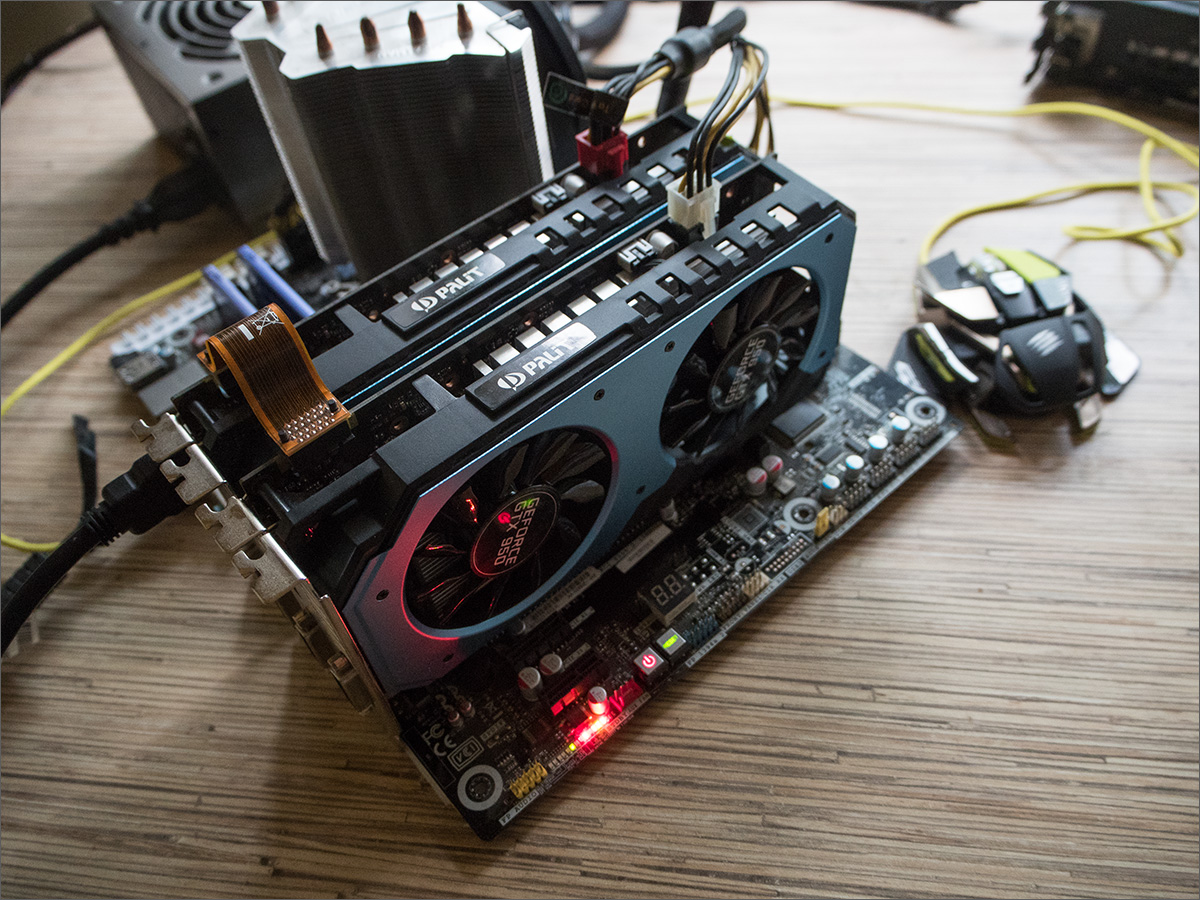
The guys from Mad Catz have long shown mice frankensheynov - replaceable parts of the design were hung on the skeleton, and the rodent transformed beyond recognition - from a super-compact mouse for lovers of finger grip into a huge monster, which can comfortably fit the entire palm. It seemed that could be improved?
Yes, in the old lines there were problems with, ahem, ahem, let's say, a weird companion application. But the new line of mice work with the new software, in which all the functions work properly, and from the “jambs” there is only a somewhat confusing and weird interface. But the interface is completely profitable.
')
In general, we thought and thought in Mad Catz, and decided that the interchangeable panels and the shape of the mouse are not hardcore. That it is necessary to give everything to set up everything And gave.
It seems that the Pro X does not change only the number of zeros on the price tag. The module itself with a sensor is removable. The choice is now available in three options, "out of the box" in the kit, only one. In my case, Pixart ADNS-9800, a popular "flagship" eye, used in many top-level gaming mice. Additional modules cost only 30 bucks (with a mouse price of ~ 200). One of them - no less popular Philips PLN2037 TwinEyeLaser, the second - for old school fans - high-quality optical Pixart PMW3310.
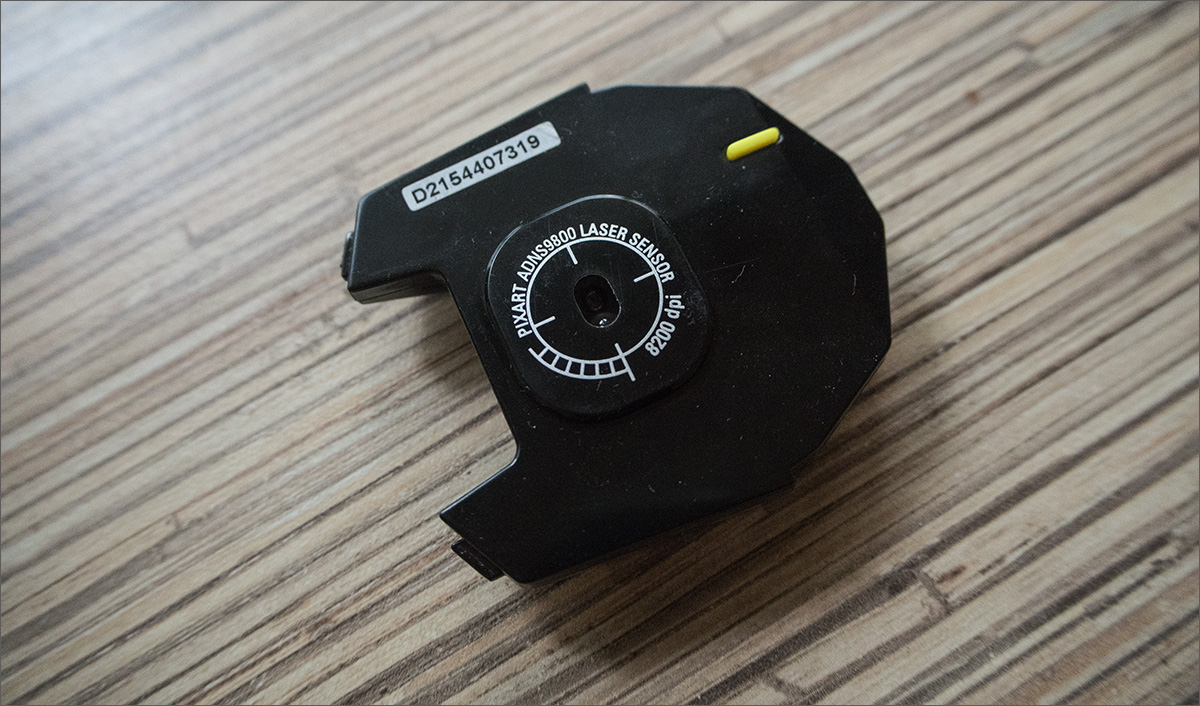
The shape of the wheel and its “sensitivity” are adjustable. Raise the takeaway, where the wheel is fixed, with the built-in cogs tighten or relax the free wheeling.

Side panel with forward / back buttons is replaced. Want simple little buttons without frills - please. High panel and a thumb pad? Is done.
Another sidebar? There is. Mouse back resizing? Well, if only the size, here you can tilt / turn to fit your hand.

Well, the most buzz - a magnetic mount for paws-slips and two sets of such paws in the set. Classic "black" stickers are installed by default: medium slip, medium or low resistance to abrasion. The second set - "white" ceramic paws. They have very low resistance, the mouse literally slides, as if greased. Despite the significant weight, the movements are surprisingly light, the sensations are very similar ... probably the trackball. At the same time, the mass and the absence of any resistance are felt, only light inertia.
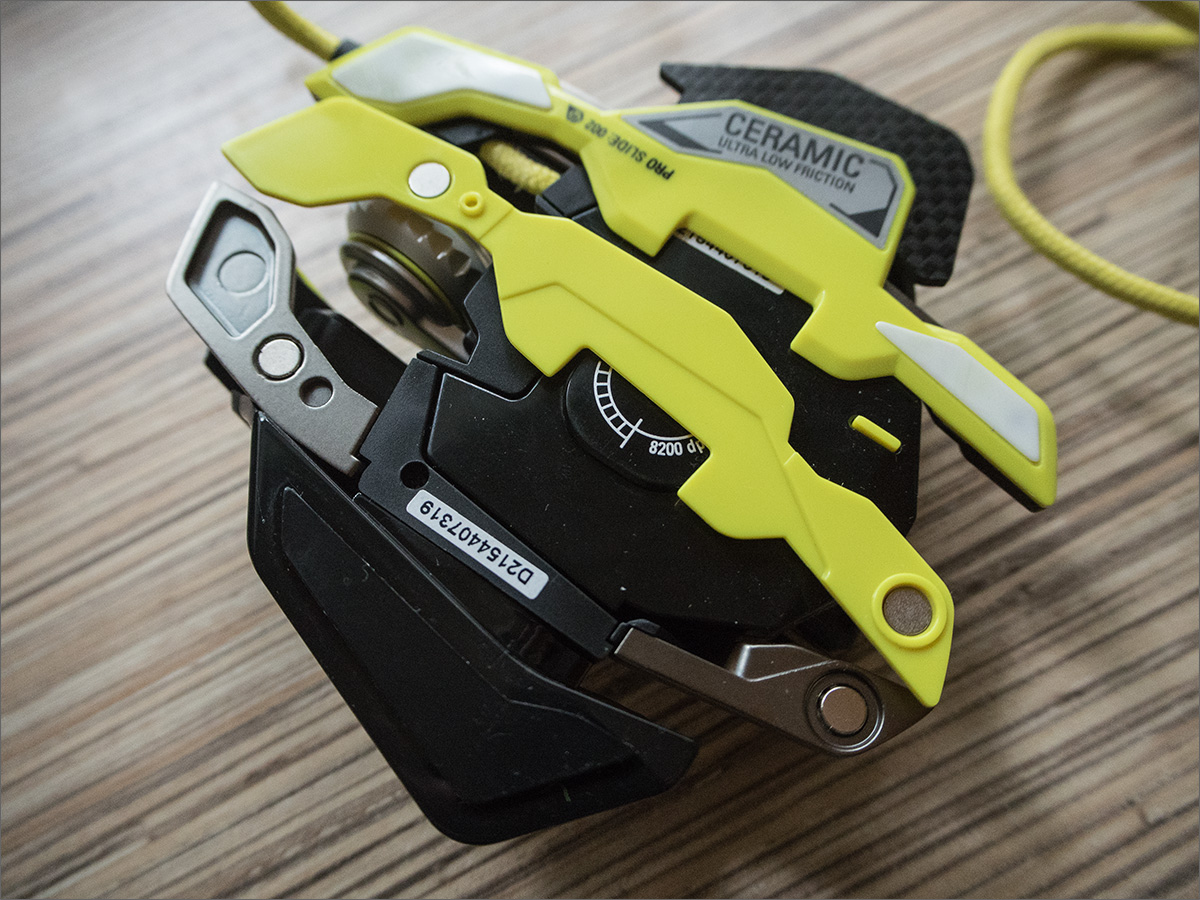
In terms of design - a typical Mad Catz, raised to the absolute. One feels continuity, it is clear what and how they changed to support new opportunities, in general, there is no feeling of alienity. If you have already used any RAT number series - you will find for yourself the comfortable values of the transformer-construction and modules that suit your personal grip. Everything else, I think, can be seen in the photo:

Personally, I had a desire to buy a mouse purely because of this feeling of tremendous ease of movement. However, do not be in a hurry, the device has some minuses, where to go without them.
The wheel has a force adjustment, but the scrolling clicks are mild, diminishing with wheel relaxation, but there is no fully inertial scroll. Here I would like just the possibility of a simple switching of such modes, like any Logitech MX Revo.
The surface is stamped and collects prints, dust, dirt literally in minutes:

The side panel with replaceable buttons is cool. Wanting to reduce the cost of construction, the developers made it with push-rods inside (the clickers themselves are at the base of the mouse), rather than a full-fledged module with its own features. I understand why it was done this way, but if you really play for all the money (and the mouse costs an indiscreet $ 200-250), you could also install a full replaceable unit. Want convenience in a graphics package - buy yourself a second wheel and buttons forwards and backwards. You play some WOW - MMO block with a dozen programmable keys. You do not like excesses, bought a mouse as a game for shooters - a simple panel with one / two / three buttons.
Well, even at the time of release and testing, the software was clearly raw - now, I am sure, it has already been revived and it sees all the possibilities of the mouse as it should. At least none of my friends who spoke with Pro X after me complained about the software.
The price for this wonder-rodent begins with an indecent 12.5 thousand rubles, and ends with quite obscene figures. However, if we consider this small piece of art as an avant-garde and amazing solution, which I personally do not know, then 13 kilo rubles is quite a reasonable price for such a toy.

The model has a younger brother, RAT Pro S - but do not be fooled by the similarity of the name. Pro S is a tournament solution. A minimum of customization, a comfortable and versatile optical sensor and a reasonable price of 70 bucks (and about 5-6 thousand rubles with us). Rather, this is not a replacement for the most successful RAT TE lineup, and not a “simplified flagship”.
A new generation of video cards has entered the market, many rushed to sell the past for a pittance to buy iron fresher. The 950s are low-end NVIDIA graphics cards that can be combined into SLI.

By itself, the NVIDIA GTX 950 is a bit of a “truncated” 960, which we use as the core of the “younger” line of Maxwell architecture chips: GM206. In simple terms, all Maxwell-based video cards (and any other, with some abstraction) consist of identical cluster blocks (GPC - Graphics Processor Cluster). Inside these GPCs, hold the unified SMM blocks associated with the rasterization block and the memory controller. In the flagship TitanX and GTX 980 (GM200 chip) there are six such blocks, the GTX 970 and 980 (GM204) have 4, but the younger ones have the GTX 950 and 960 - only two:

Since each cluster contains its own memory controller, which evenly “distributes” the memory bus across SMM blocks, the video cards have a common memory bus (348bit for GM200, 256bit - GM204, 128bit - GM206)
In the 950th, the same GM206 is used, but out of 16 SMM blocks, only 12 are left working.

What does this actually give us? With such a memory bus and only two memory controllers on the video card there will be only 2 GB of video memory - it will no longer be able to process it stupidly. The memory bandwidth of the GTX 950 is ~ 112 Gbit / s. That is, even if the GTX 950 hypothetically came out with 3 or 4 GB of memory, the difference in performance would be much less than the difference in price. Approximately the same thing, by the way, is going on with the GTX 960 - using FullHD to take the 4GB option, paying $ 50 more (almost of the video card price) is stupid, and at higher resolutions the video card will already be reduced to the more modest computing unit. Yes, in this case there are rare exceptions in the form of a couple of games, and if the video card is taken just for them ... But we did not come here for that.
So, the two 950s can be combined with an SLI bridge and forced to work together. If you roughly add up their computing power, you’ll get almost a GTX 970, but, unfortunately, we have an SLI, not a Crossfire, and it would be nice to get at least 80% growth. Here, by the way, you for comparison GTX 950 next to the HD7970. Two pieces of 950 should be at the level of this heavyweight.
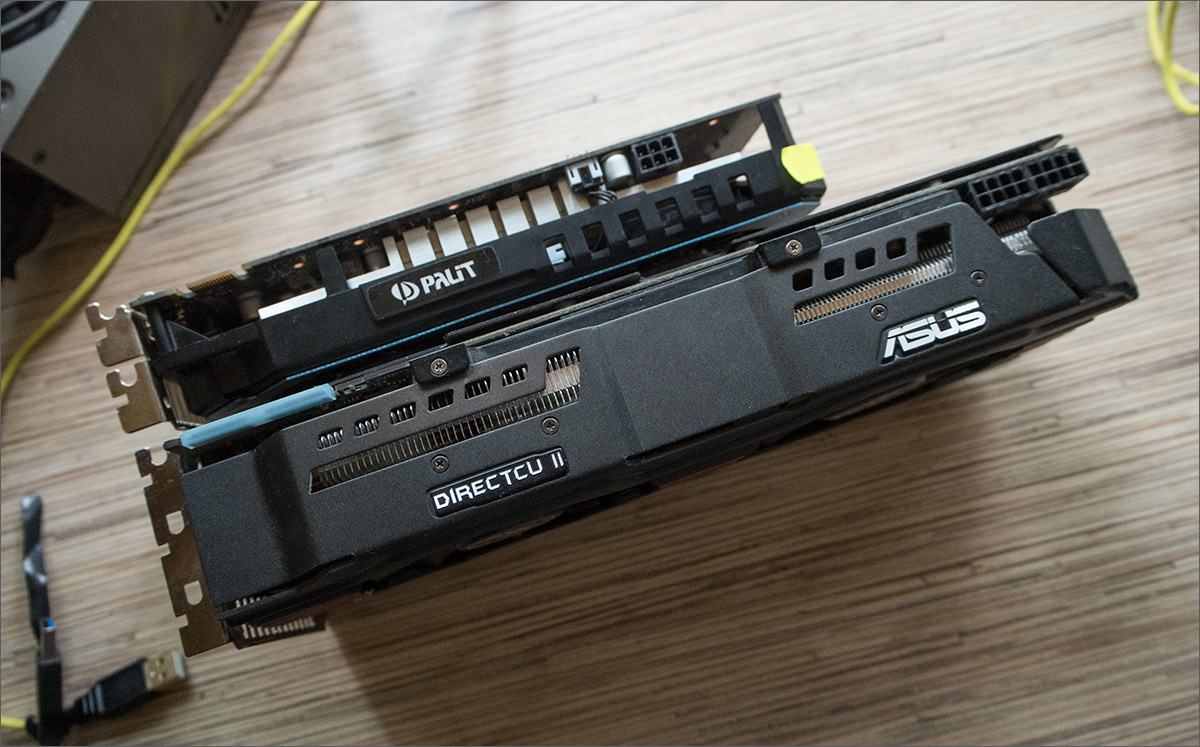
In short, SLI (at least as far as the Kepler family, something new was introduced there) works on the basis of legacy crutches. One video card is considered “main”, the rest obey it. Load can be distributed in two ways. The first option is to render one video card from 30 to 70% of the top of the frame (the proportion changes dynamically depending on the complexity of the scene), and the other on the bottom. Option two - video cards take turns drawing frames (one is even, the other is odd).
Both options have their drawbacks. In the first case, there may be "gaps" in performance, and overhead resources for synchronizing work are higher, in the second, full duplication of data in the memory of video cards is required, and there is some chance that the load from frame to frame will be uneven. However, in modern AAA-taytlah load such that it is more than enough for both cards.
So let's say you have 2 pieces of a GTX 950, an SLI bridge and a desire to experiment. I conducted tests on three games in four versions, the rest - I took from open sources. The desire to use two 950s in SLI may arise when using a monitor that supports a high resolution - 2560x1440 or 3820x2160. In the case of 4k2k, I want to say thanks to the guys from MMD Monitors & Displays for providing Philips 288P6LJEB for the time being. Excellent srednjak on a good TN-matrix. After calibration produces acceptable colors, the eyes do not get tired, there are no special complaints about ergonomics.
If one video card for working at native resolution is obviously not enough, then two of them have convincing chances to show a decent result.
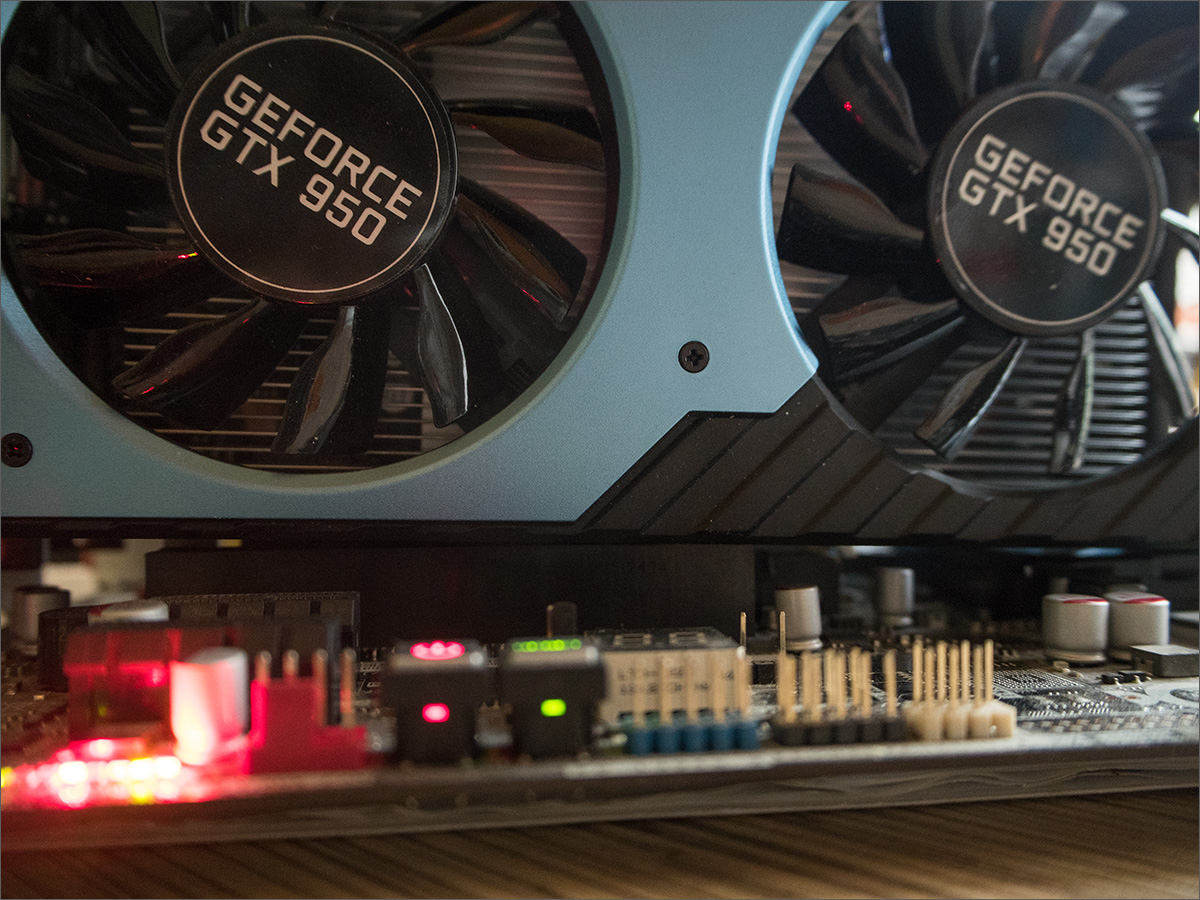
For a good example, let's take a game that still produces an amazing picture, despite the fact that she herself is far from new. GTA V is a huge open world, amazingly crafted, detailed and stylish. The game is greedy for resources, but it goes very well even on medium configurations - naturally, with lower settings. And she also perfectly digests any amount of resources available to her.
So, one GTX 950 in the native resolution of 2560x1440 with the settings “all on high” gives out from 18.5 to 22-24 frames, depending on the scene. The main problem is lack of memory. An abrupt change of environment, rapid movement (especially flight) lead to FPS subsidence and friezes / loadings. On 4k2k, the situation is even sadder - there 20 FPS is the ultimate dream.

Two video cards allow you to get playable 30 FPS on 4k2k and ... ~ the same 31 FPS on average 2560x1440.

The attentive reader has probably already guessed that if the performance practically does not change with increasing resolution, then we do not run into the computational capabilities of video cards. Right! All cant - in the amount of available memory. Despite the fact that the games see a total amount of 4 GB of video memory, in reality, for each of the frames, a maximum of 2 GB is used and they are connected via a 128-bit bus. We reduce the main “loading” memory setting - texture resolution - to “medium”, and in 4k2k the maximum FPS grows to 39.1, at 2560x1440 - to 51. FullHD with “average” textures gives already confident 60+ FPS (and rests on Vsync of ordinary monitors ), and the more we are not interested - to play and watch breaks without vertical synchronization is a pleasure.

Interestingly, with the “high” texture settings, even FullHD periodically starts to subside - which means the weakest point of the Sparky is the memory bandwidth (and volume). It remains to check what is missing specifically - quantity or quality. GDDR5 memory perfectly responds to overclocking. Each megahertz in the control panel will give us 4 real ones (for data, not instructions), the video card works “from the factory” with memory at 6.6–6.7 GHz, the best copies easily add 1 effective gigahertz to these results.
My video cards were able to take 7.4 Ghz without any problems. Let's see what has changed in the resolution of 2560x1440 and 4k2k with “medium” textures. The average FPS grew by almost 7%.
In this case, we got a good performance boost from the second video card, but the GTA as a whole is written so that no matter how much you give it ... But, for example, in the very same Dark Souls III, there was simply no support for the SLI release (or rather, it was, but not everyone worked - in my case, the second video card kicked a bolt and was loaded by 5-7%), in some (curves, in my opinion) potato engines, the presence of a second video card is a lottery, and can lead not to improvement, but to deterioration of the average FPS. So here is a double-edged sword.
2 pieces of GTX 950 give “acceptable”> 30 FPS at resolutions up to 4k2k in many modern games (BF Hardline, Thief, GTA V, Crysis, LotR: BFME HQ, WarThunder, Dark Souls III), and even in such hot new products, like Doom or Forza Motorsport 6 Apex). However, with a 4k2k monitor and its pixel density, you can safely play at “incomplete” resolution, with anti-aliasing, and enjoy a much smoother picture - the main thing to remember is that you have a modest 2 GB of video memory left.

Well, for FullHD this is a great option, really ... most likely, if you built / upgraded the computer and took the GTX 950, you are unlikely to have a power reserve for the PSU and processor to install the second one.
SLI from the 950s has the right to life if you had one video card, and you found the second one on the street / took it from a friend for beer / took it away from kindergarteners or simply snatched it free. You will get excellent results on FullHD-resolution in those games where SLI works well (especially if you don’t go too far with the memory-dependent settings). Moreover, the resolutions 2560x1440 and even 4k2k will become available to you (with certain costs, of course), but on the “console” graph and FPS indices.
The deliberate purchase of a second video card (new!) For SLI will be less rational than selling the one on the secondary and buying one powerful one - for example, the GTX 970. (And ideally, wait for the official prices for the RX 480 and compare it with the GTX 970). The price difference between the GTX 970 and GTX 950 is almost doubled - and buying two (or buying another one) 950 will cost you about the same amount (considering a separate purchase of an SLI bridge), but the average performance increase will not be as great as with the direct upgrade. Add to this the requirements of a suitable motherboard (with two full-speed PCI-E x16 soldered on the motherboard), a good power supply, higher than in the case of a single video card CPU overhead ... Besides, a new generation of top NVIDIA is now out , and the prices of the older cards of the past will go down sharply. In general, the game worth the candle, if the second video card, by coincidence, went to you for a penny, and the rest of the hardware allows you to use SLI.
PS: Say hello to those cretins who invented this:
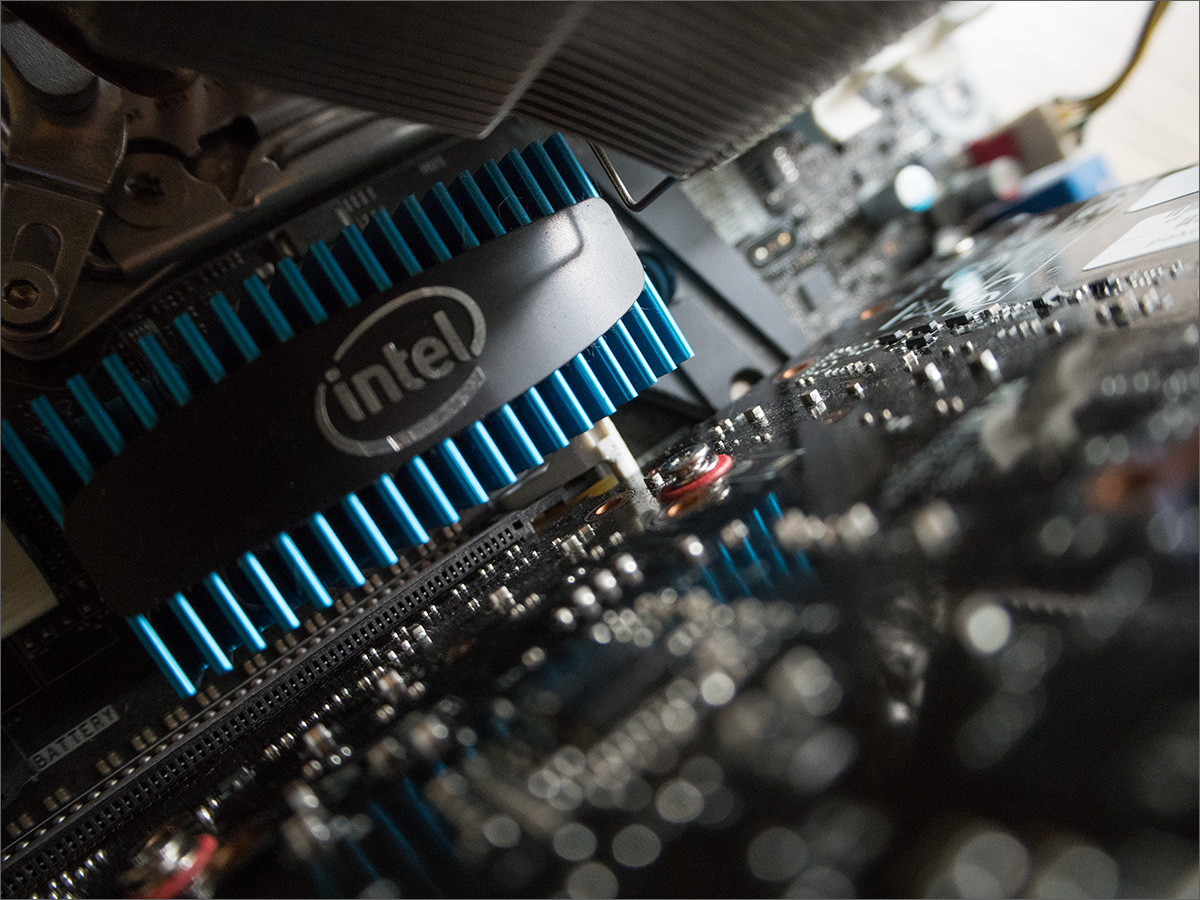
Thank you guys, it was just awesome to have fun trying to open the lock.
Like that:


Mad Catz RAT Pro X - the Frankenstein monster and the crown of evolution
The guys from Mad Catz have long shown mice frankensheynov - replaceable parts of the design were hung on the skeleton, and the rodent transformed beyond recognition - from a super-compact mouse for lovers of finger grip into a huge monster, which can comfortably fit the entire palm. It seemed that could be improved?
Yes, in the old lines there were problems with, ahem, ahem, let's say, a weird companion application. But the new line of mice work with the new software, in which all the functions work properly, and from the “jambs” there is only a somewhat confusing and weird interface. But the interface is completely profitable.
')
In general, we thought and thought in Mad Catz, and decided that the interchangeable panels and the shape of the mouse are not hardcore. That it is necessary to give everything to set up everything And gave.
Dali to the fullest!
It seems that the Pro X does not change only the number of zeros on the price tag. The module itself with a sensor is removable. The choice is now available in three options, "out of the box" in the kit, only one. In my case, Pixart ADNS-9800, a popular "flagship" eye, used in many top-level gaming mice. Additional modules cost only 30 bucks (with a mouse price of ~ 200). One of them - no less popular Philips PLN2037 TwinEyeLaser, the second - for old school fans - high-quality optical Pixart PMW3310.

The shape of the wheel and its “sensitivity” are adjustable. Raise the takeaway, where the wheel is fixed, with the built-in cogs tighten or relax the free wheeling.

Side panel with forward / back buttons is replaced. Want simple little buttons without frills - please. High panel and a thumb pad? Is done.
Another sidebar? There is. Mouse back resizing? Well, if only the size, here you can tilt / turn to fit your hand.

Well, the most buzz - a magnetic mount for paws-slips and two sets of such paws in the set. Classic "black" stickers are installed by default: medium slip, medium or low resistance to abrasion. The second set - "white" ceramic paws. They have very low resistance, the mouse literally slides, as if greased. Despite the significant weight, the movements are surprisingly light, the sensations are very similar ... probably the trackball. At the same time, the mass and the absence of any resistance are felt, only light inertia.

Appearance
In terms of design - a typical Mad Catz, raised to the absolute. One feels continuity, it is clear what and how they changed to support new opportunities, in general, there is no feeling of alienity. If you have already used any RAT number series - you will find for yourself the comfortable values of the transformer-construction and modules that suit your personal grip. Everything else, I think, can be seen in the photo:

Inner peace and impressions
Personally, I had a desire to buy a mouse purely because of this feeling of tremendous ease of movement. However, do not be in a hurry, the device has some minuses, where to go without them.
The wheel has a force adjustment, but the scrolling clicks are mild, diminishing with wheel relaxation, but there is no fully inertial scroll. Here I would like just the possibility of a simple switching of such modes, like any Logitech MX Revo.
The surface is stamped and collects prints, dust, dirt literally in minutes:

The side panel with replaceable buttons is cool. Wanting to reduce the cost of construction, the developers made it with push-rods inside (the clickers themselves are at the base of the mouse), rather than a full-fledged module with its own features. I understand why it was done this way, but if you really play for all the money (and the mouse costs an indiscreet $ 200-250), you could also install a full replaceable unit. Want convenience in a graphics package - buy yourself a second wheel and buttons forwards and backwards. You play some WOW - MMO block with a dozen programmable keys. You do not like excesses, bought a mouse as a game for shooters - a simple panel with one / two / three buttons.
Well, even at the time of release and testing, the software was clearly raw - now, I am sure, it has already been revived and it sees all the possibilities of the mouse as it should. At least none of my friends who spoke with Pro X after me complained about the software.
Sadness sadness
The price for this wonder-rodent begins with an indecent 12.5 thousand rubles, and ends with quite obscene figures. However, if we consider this small piece of art as an avant-garde and amazing solution, which I personally do not know, then 13 kilo rubles is quite a reasonable price for such a toy.

The model has a younger brother, RAT Pro S - but do not be fooled by the similarity of the name. Pro S is a tournament solution. A minimum of customization, a comfortable and versatile optical sensor and a reasonable price of 70 bucks (and about 5-6 thousand rubles with us). Rather, this is not a replacement for the most successful RAT TE lineup, and not a “simplified flagship”.
GTX 950 SLI on the example of the Palit GTX 950 StormX Dual
A new generation of video cards has entered the market, many rushed to sell the past for a pittance to buy iron fresher. The 950s are low-end NVIDIA graphics cards that can be combined into SLI.

By itself, the NVIDIA GTX 950 is a bit of a “truncated” 960, which we use as the core of the “younger” line of Maxwell architecture chips: GM206. In simple terms, all Maxwell-based video cards (and any other, with some abstraction) consist of identical cluster blocks (GPC - Graphics Processor Cluster). Inside these GPCs, hold the unified SMM blocks associated with the rasterization block and the memory controller. In the flagship TitanX and GTX 980 (GM200 chip) there are six such blocks, the GTX 970 and 980 (GM204) have 4, but the younger ones have the GTX 950 and 960 - only two:

Since each cluster contains its own memory controller, which evenly “distributes” the memory bus across SMM blocks, the video cards have a common memory bus (348bit for GM200, 256bit - GM204, 128bit - GM206)
In the 950th, the same GM206 is used, but out of 16 SMM blocks, only 12 are left working.

What does this actually give us? With such a memory bus and only two memory controllers on the video card there will be only 2 GB of video memory - it will no longer be able to process it stupidly. The memory bandwidth of the GTX 950 is ~ 112 Gbit / s. That is, even if the GTX 950 hypothetically came out with 3 or 4 GB of memory, the difference in performance would be much less than the difference in price. Approximately the same thing, by the way, is going on with the GTX 960 - using FullHD to take the 4GB option, paying $ 50 more (almost of the video card price) is stupid, and at higher resolutions the video card will already be reduced to the more modest computing unit. Yes, in this case there are rare exceptions in the form of a couple of games, and if the video card is taken just for them ... But we did not come here for that.
So, the two 950s can be combined with an SLI bridge and forced to work together. If you roughly add up their computing power, you’ll get almost a GTX 970, but, unfortunately, we have an SLI, not a Crossfire, and it would be nice to get at least 80% growth. Here, by the way, you for comparison GTX 950 next to the HD7970. Two pieces of 950 should be at the level of this heavyweight.

How SLI works
In short, SLI (at least as far as the Kepler family, something new was introduced there) works on the basis of legacy crutches. One video card is considered “main”, the rest obey it. Load can be distributed in two ways. The first option is to render one video card from 30 to 70% of the top of the frame (the proportion changes dynamically depending on the complexity of the scene), and the other on the bottom. Option two - video cards take turns drawing frames (one is even, the other is odd).
Both options have their drawbacks. In the first case, there may be "gaps" in performance, and overhead resources for synchronizing work are higher, in the second, full duplication of data in the memory of video cards is required, and there is some chance that the load from frame to frame will be uneven. However, in modern AAA-taytlah load such that it is more than enough for both cards.
What can be achieved at two 950 in SLI
So let's say you have 2 pieces of a GTX 950, an SLI bridge and a desire to experiment. I conducted tests on three games in four versions, the rest - I took from open sources. The desire to use two 950s in SLI may arise when using a monitor that supports a high resolution - 2560x1440 or 3820x2160. In the case of 4k2k, I want to say thanks to the guys from MMD Monitors & Displays for providing Philips 288P6LJEB for the time being. Excellent srednjak on a good TN-matrix. After calibration produces acceptable colors, the eyes do not get tired, there are no special complaints about ergonomics.
If one video card for working at native resolution is obviously not enough, then two of them have convincing chances to show a decent result.

For a good example, let's take a game that still produces an amazing picture, despite the fact that she herself is far from new. GTA V is a huge open world, amazingly crafted, detailed and stylish. The game is greedy for resources, but it goes very well even on medium configurations - naturally, with lower settings. And she also perfectly digests any amount of resources available to her.
So, one GTX 950 in the native resolution of 2560x1440 with the settings “all on high” gives out from 18.5 to 22-24 frames, depending on the scene. The main problem is lack of memory. An abrupt change of environment, rapid movement (especially flight) lead to FPS subsidence and friezes / loadings. On 4k2k, the situation is even sadder - there 20 FPS is the ultimate dream.

Two video cards allow you to get playable 30 FPS on 4k2k and ... ~ the same 31 FPS on average 2560x1440.

The attentive reader has probably already guessed that if the performance practically does not change with increasing resolution, then we do not run into the computational capabilities of video cards. Right! All cant - in the amount of available memory. Despite the fact that the games see a total amount of 4 GB of video memory, in reality, for each of the frames, a maximum of 2 GB is used and they are connected via a 128-bit bus. We reduce the main “loading” memory setting - texture resolution - to “medium”, and in 4k2k the maximum FPS grows to 39.1, at 2560x1440 - to 51. FullHD with “average” textures gives already confident 60+ FPS (and rests on Vsync of ordinary monitors ), and the more we are not interested - to play and watch breaks without vertical synchronization is a pleasure.

Interestingly, with the “high” texture settings, even FullHD periodically starts to subside - which means the weakest point of the Sparky is the memory bandwidth (and volume). It remains to check what is missing specifically - quantity or quality. GDDR5 memory perfectly responds to overclocking. Each megahertz in the control panel will give us 4 real ones (for data, not instructions), the video card works “from the factory” with memory at 6.6–6.7 GHz, the best copies easily add 1 effective gigahertz to these results.
My video cards were able to take 7.4 Ghz without any problems. Let's see what has changed in the resolution of 2560x1440 and 4k2k with “medium” textures. The average FPS grew by almost 7%.
In this case, we got a good performance boost from the second video card, but the GTA as a whole is written so that no matter how much you give it ... But, for example, in the very same Dark Souls III, there was simply no support for the SLI release (or rather, it was, but not everyone worked - in my case, the second video card kicked a bolt and was loaded by 5-7%), in some (curves, in my opinion) potato engines, the presence of a second video card is a lottery, and can lead not to improvement, but to deterioration of the average FPS. So here is a double-edged sword.
2 pieces of GTX 950 give “acceptable”> 30 FPS at resolutions up to 4k2k in many modern games (BF Hardline, Thief, GTA V, Crysis, LotR: BFME HQ, WarThunder, Dark Souls III), and even in such hot new products, like Doom or Forza Motorsport 6 Apex). However, with a 4k2k monitor and its pixel density, you can safely play at “incomplete” resolution, with anti-aliasing, and enjoy a much smoother picture - the main thing to remember is that you have a modest 2 GB of video memory left.

Well, for FullHD this is a great option, really ... most likely, if you built / upgraded the computer and took the GTX 950, you are unlikely to have a power reserve for the PSU and processor to install the second one.
Summing up
SLI from the 950s has the right to life if you had one video card, and you found the second one on the street / took it from a friend for beer / took it away from kindergarteners or simply snatched it free. You will get excellent results on FullHD-resolution in those games where SLI works well (especially if you don’t go too far with the memory-dependent settings). Moreover, the resolutions 2560x1440 and even 4k2k will become available to you (with certain costs, of course), but on the “console” graph and FPS indices.
The deliberate purchase of a second video card (new!) For SLI will be less rational than selling the one on the secondary and buying one powerful one - for example, the GTX 970. (And ideally, wait for the official prices for the RX 480 and compare it with the GTX 970). The price difference between the GTX 970 and GTX 950 is almost doubled - and buying two (or buying another one) 950 will cost you about the same amount (considering a separate purchase of an SLI bridge), but the average performance increase will not be as great as with the direct upgrade. Add to this the requirements of a suitable motherboard (with two full-speed PCI-E x16 soldered on the motherboard), a good power supply, higher than in the case of a single video card CPU overhead ... Besides, a new generation of top NVIDIA is now out , and the prices of the older cards of the past will go down sharply. In general, the game worth the candle, if the second video card, by coincidence, went to you for a penny, and the rest of the hardware allows you to use SLI.
PS: Say hello to those cretins who invented this:

Thank you guys, it was just awesome to have fun trying to open the lock.
Source: https://habr.com/ru/post/396001/
All Articles